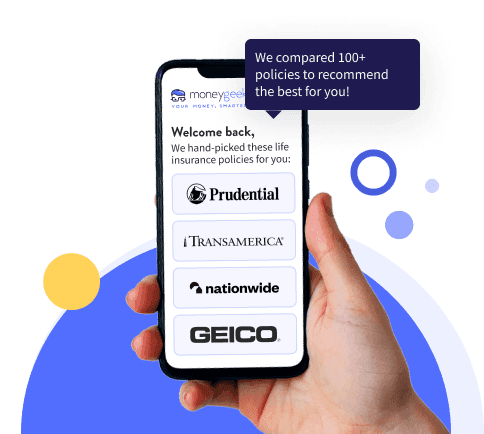Adjustable life insurance is permanent coverage that lets you change your premium payments, death benefit and cash value as your finances shift. You can scale your death benefit up or down and adjust premiums to match financial changes, keeping your policy relevant across different life stages.
What Is Adjustable Life Insurance?
Adjustable life insurance gives you lifetime coverage with the flexibility to change your premiums and death benefit as your life evolves.
Find out if you're overpaying for life insurance below.

Updated: December 12, 2025
Advertising & Editorial Disclosure
Adjustable life insurance (also called flexible life insurance) lets you modify three key features: premiums, death benefits and cash value.
This coverage works well if you need flexibility because of income changes or family transitions.
Before adjusting your policy, contact your insurer to understand the process. Some changes, like raising your death benefit, require new underwriting.
Ensure you are getting the best rate for your insurance. Compare quotes from the top insurance companies.
Adjustable Life Insurance Definition
Characteristics of an Adjustable Life Policy
Unlike fixed policies that lock you into specific terms, adjustable coverage grows and changes with your life through three key features:
Increase premiums to accelerate cash value growth, or reduce them during tight financial periods without losing coverage.
Raise your death benefit after a child's birth or new mortgage. Lower it when children become independent or debt disappears, reducing premium costs.
Access funds during the policy term through loans or withdrawals. This acts as a financial cushion during unexpected circumstances, though managing it affects your policy's longevity.
Adjustable life insurance is universal life insurance with a different name. The flexibility is what makes it appealing. You can raise or lower your premiums and death benefit as needed. If money gets tight, your cash value can cover premium payments, so you won't lose coverage during tough financial periods.
Also read: Best Universal Life Insurance Companies
How Does Adjustable Life Insurance Work?
Like other types of life insurance, adjustable life insurance pays your beneficiaries a death benefit when you pass away. Premium payments keep coverage active.
What sets adjustable life insurance apart: you can change your premiums and death benefit when your life circumstances shift.
Adjustable Life Insurance Payment Structure
Each premium payment splits into insurance costs (covering the death benefit), policy expenses (administrative fees) and cash value accumulation.
Cash value grows over time and sustains the policy when you reduce or temporarily stop premium payments.
You can modify these components within certain limits: adjust how much goes toward cash value versus insurance costs, change your death benefit amount and vary premium payments based on your budget.
Your adjustable life policy offers three payment approaches:
- Minimum payment: Just enough to prevent policy lapse. This covers basic insurance costs and fees but won't build much cash value.
Target payment: The sweet spot most insurers recommend. This maintains your coverage for life while steadily building cash value.
Maximum payment: The most you can contribute under tax laws. This accelerates cash value growth for better tax-deferred savings potential.
How the Cash Value Component Functions
Part of each premium payment goes to the cash account that grows over time. Depending on the policy type, this cash value earns interest or investment returns. You can use the cash value while you're alive through loans and withdrawals.
When you can't make premium payments due to job loss or unexpected expenses, your policy automatically pulls from the cash value to cover insurance costs and maintain coverage.
Adjustable Life Insurance Policy: Tax Implications
The tax advantages of adjustable life insurance boost your long-term financial strategy, but understanding the rules is essential:
- Tax-Deferred Growth: Cash value in your policy grows tax-deferred. Earnings stay invested without annual taxes. You pay taxes only when withdrawing money.
- Withdrawals vs. Loans: Withdrawals up to your total premium payments are tax-free. Amounts above that are taxed as ordinary income. Borrowing against your policy isn't taxed because the IRS treats loans as debt, not income. If the policy lapses with an unpaid balance, the remaining loan amount may become taxable.
- IRS Compliance Requirements: Your policy must comply with Internal Revenue Code Section 7702 to maintain tax benefits. The code limits contributions relative to your death benefit. Exceed these limits, and your policy loses favorable tax treatment.
- Modified Endowment Contract (MEC) Rules: The IRS uses the MEC test to limit premium payments within the first seven policy years. If you exceed MEC limits, you lose tax-free loan access. Withdrawals and loans become taxable, and you may face a 10% penalty on earnings if you're under age 59½.
Tax rules change frequently and vary by individual circumstances. This information is for educational purposes only and should not be considered tax advice. Consult a qualified tax professional about your specific situation.
Learn More: Is Life Insurance Taxable?
Adjusting Your Adjustable Life Policy
To adjust your policy, contact your insurance provider to discuss the changes you want to make. Whether you're increasing the death benefit due to family growth, reducing premiums because of changing finances or adjusting cash value for better investment returns, your insurer can guide you through the process.
Some changes require additional underwriting, particularly if they involve increasing the death benefit.
Requirement | Description |
|---|---|
Timing Restrictions and Limitations | Most insurers allow adjustments annually or semi-annually, though you can make some changes more often. Death benefit increases require medical underwriting, which takes two to four weeks. Premium adjustments take effect within 30 days of approval. |
Documentation Requirements | Increasing death benefits requires updated medical information, financial statements and sometimes a new medical exam. Premium reductions need minimal paperwork. Cash value allocation changes need investment election forms. |
Minimum Premium Requirements | Each policy has minimum premium requirements to cover insurance costs and keep the policy active. Pay less than the minimum, and your policy lapses. Your insurer provides specific minimum payment amounts based on your age, death benefit and policy performance. |
-
Death Benefit Increases: Raising your death benefit can trigger a medical exam. The required increase varies by insurer, but many use thresholds of more than $100,000 or greater than 25% of original coverage.
-
Documentation: Large increases often require financial statements. Health questionnaires may be needed for benefit changes, and beneficiary updates need proper identification forms.
-
Approval Timeline: Straightforward adjustments may complete within five to 10 business days, while requests involving medical review can take four to six weeks.
-
No Underwriting Needed: Premium changes within policy limits, cash value loans or withdrawals and standard beneficiary updates usually don't require new underwriting.
MoneyGeek Tip: Request benefit increases when you're healthy. Strong medical records speed up the underwriting process.
Types of Adjustable Life Insurance
Adjustable life insurance comes in several types, each designed for different comfort levels with risk and investment control. Options include indexed policies (where your cash value follows market indexes) or multifunded policies (letting you spread money across different investment choices).
- Flexible Premium Adjustable Life lets you adjust payments based on your income. Pay extra when earnings increase. Reduce payments during tight periods, provided you meet the minimum required to maintain coverage.
- Indexed Adjustable Life ties cash value growth to market indexes like the S&P 500. Your gains cap at 10% to 12% annually, while a guaranteed floor (usually 0% to 2%) protects against losses.
- Variable Adjustable Life puts you in control of investments. You direct cash value into subaccounts that function like mutual funds. Variable policies deliver the highest growth potential with the highest risk; your cash value drops when investments underperform.
- Multifunded Adjustable Life offers several investment channels: bond funds, stock funds and money market accounts. You spread cash value across these options and shift allocations as your risk tolerance evolves.
Not all insurers offer every type. Product features and availability vary by company. A financial advisor or insurance agent can help match policy types to your financial goals and risk tolerance.
Adjustable Life Insurance Pros and Cons
Adjustable life insurance delivers flexibility for changing circumstances but demands ongoing oversight and carries risks worth evaluating before purchase.
- Adapts to life changes
- Built-in emergency fund access (cash value)
- Faster cash value growth potential than traditional whole life
- Tax-advantaged borrowing and growth
- Cash value can disappear if you take too many loans or pay only minimum
- Policy can lapse if you skip payments or withdraw too much cash value
- Requires active management and ongoing monitoring
- Higher upfront costs than term life
Unlike term life insurance, adjustable policies need ongoing attention. Review your policy annually or when your life changes. Adjust your premiums, death benefit or investment mix to keep the policy working for you.
What Is an Adjustable Life Insurance Policy: Bottom Line
Adjustable life insurance (also called flexible life insurance) lets you modify premiums, death benefits and cash value to suit changing financial circumstances and life stages.
Adjustable life insurance benefits those expecting life changes, like family expansion or financial shifts. You can raise or lower your death benefit based on current needs, matching coverage to your life's demands without overpaying.
Compare Life Insurance Rates
Ensure you are getting the best rate for your insurance. Compare quotes from the top insurance companies.
Adjustable Life Insurance: FAQ
We answer common questions about adjustable life insurance policies.
Is adjustable life insurance right for you?
Adjustable life insurance suits people who anticipate financial changes, seek investment opportunities or need long-term flexible coverage. Skip it if you prefer simplicity, have a tight budget, want a hands-off policy or need only short-term coverage.
Can I cash in a flexible premium adjustable life insurance policy?
If you have a flexible premium adjustable life policy, you can cash it in to access the accumulated cash value. Surrender charges may apply and accessing funds may reduce the policy's death benefit and potential future growth.
Who can request changes in premium payments, face value, loans and policy plans in an adjustable life insurance policy?
If you own an adjustable life insurance policy, you have the authority to request changes to the policy, including updates to premium payments, death benefit and other policy features. These adjustments work with your changing finances or goals.
Can I buy flexible term life insurance?
"Flexible term life insurance" isn't available from most insurers. Regular term life insurance locks you into fixed premiums and coverage amounts for the entire term, so you can't adjust either once your policy starts.
Can I buy an adjustable whole life policy?
The term "adjustable whole life insurance" doesn't refer to a standard policy type in the insurance industry. Traditional whole life insurance offers fixed premiums, a fixed death benefit and a cash value component that grows at a guaranteed rate.
Some insurance providers market more flexible whole life insurance options, allowing customization, but these don't have the same features as adjustable life insurance.
Related Pages
About Mark Fitzpatrick

Mark Fitzpatrick, a Licensed Property and Casualty Insurance Producer, is MoneyGeek's resident Personal Finance Expert. With over five years of experience analyzing the insurance market, he conducts original research and creates tailored content for all types of buyers. His insights have been featured in publications like CNBC, NBC News and Mashable.
Fitzpatrick holds a master’s degree in economics and international relations from Johns Hopkins University and a bachelor’s degree from Boston College. He's also a five-time Jeopardy champion!
He writes about economics and insurance, breaking down complex topics so people know what they're buying.
sources
- Internal Revenue Service. "Definition of Modified Endowment Contract (MEC)." Accessed November 6, 2025.
- Internal Revenue Service. "7702. Life Insurance Contract Defined." Accessed November 6, 2025.






